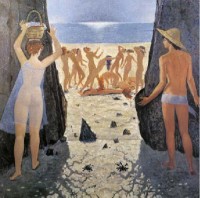By Daniela Quadrelli (University of Florence)
The exhibit, held at Villa Bardini, ends the 19th of October 2014, and it is possible to visit the first anthological exhibit dedicated to Giovanni Colacicchi, who passed away in 1992. Colacicchi, born in Anagni, was a poet and a self-taught painter who received a classical education in the province of Frosinone. He then moved to Florence in 1919. His poetry is characterized by a constant search for the myth through poetry, dance and music.
The exhibit is located on the third floor of the villa and is subdivided into four chronological sections, covering the arc of the artist’s life from the thirties to the eighties, followed by three main themes: the relationship with the music, the commissions for public buildings, and the nude.
The walls of the rooms are paneled in a dark green fabric, instead of highlighting the works; this undermines their perception making the environment gloomy. A didactic panel that describes the section in a rather short historical context or theme of reference distinguishes each section. This encourages the public to spend more time on direct observation of works. A yellow plexiglass label that shows the year, the technique used, and the origin, accompanies each work. The lighting is mostly artificial, perhaps chosen to better protect the works. Unfortunately, the windows in which the visitors would admire the beautiful views are closed and shuttered.
On the contrary however, through the corridor that follows the first section, the sunlight illuminates the artist’s work places on the opposite wall, allowing a clearer viewing. At the same time, it allows for a nice view of the Villa’s gardens and of Florence.
Although the exhibition is a series of chronological and thematic sections well laid out, the pathway is not very clear and because of the lack of appropriate directional signs, the visitors often risk losing the thread of the discourse. In addition, the introductory panels, placed in the rooms instead of the entryway, do not help the visitor.
At the end of the path, in order to reach the exit, you are obliged to return to the ticket office and follow the way (quite labyrinthine). You will come unexpectedly into a large room where you are exposed to a large painting titled Allegory of dance and music for a cinema (1948).
It is a representative dance of young people that was carried out by Colacicchi at the height of his artistic maturity for the film Gambrinus in Florence. This work epitomizes the philosophy of this artist, or the dream of the union of the arts: painting, music, poetry, dance, comedy, and philosophy.
The ticket also allows access to the Museo Annigoni, al Museum Roberto Capucci, and the gardens of Villa Bardini.
For more information, please visit this site for English: http://www.giovannicolacicchi.com/florence-exhibit-2014/
And for Italian: http://www.bardinipeyron.it/ab/cont__0_533.phtml#533
Giovanni Colacicchi – Figure di ritmo e di luce nella Firenze del ‘900
Daniela Quadrelli (Università di Firenze)
Nel complesso di Villa Bardini fino al 19 ottobre 2014 è possibile visitare la prima mostra antologica dedicata a Giovanni Colacicchi, scomparso nel1992. Egli, poeta e pittore autodidatta di educazione classica nato ad Anagni in provincia di Frosinone, si trasferì a Firenze nel 1919. La sua poetica si distingue per una costante ricerca del mito attraverso la poesia, la danza e la musica.
La mostra si sviluppa al terzo piano della villa ed è suddivisa in quattro sezioni cronologiche che ricoprono l’arco della vita dell’artista dagli anni Trenta agli anni Ottanta, seguendo tre tematiche principali: il rapporto con la musica, le commissioni per edifici pubblici e il nudo.
Le pareti delle sale sono rivestite di pannelli di tessuto verde scuro che, invece di mettere in evidenza le opere, minano la loro percezione, rendendo cupo l’ambiente. Ogni sezione è distinta da un pannello didascalico che descrive in modo piuttosto breve il contesto storico o il tema di riferimento, stimolando il pubblico a dedicare più tempo all’osservazione diretta delle opere. Ognuna di queste è dotata di un cartellino in plexiglass che riporta l’anno, la tecnica utilizzata e la provenienza. L’illuminazione è per lo più artificiale: scelta probabilmente per una migliore protezione delle opere ma discapito dello splendido panorama che si ammirerebbe da tutte le finestre, purtroppo chiuse ed oscurate.
Al contrario, passando per il corridoio che segue la prima sezione, la luce del sole illumina i lavori dell’artista posti nella parete di fronte alle finestre, consentendone una più chiara lettura e allo stesso tempo permettendo una piacevole veduta sui giardini della villa e su Firenze.
Sebbene la mostra sia un susseguirsi di sezioni cronologiche e tematiche ben strutturate, il percorso di visita non è molto chiaro e a causa della mancanza di opportune indicazioni direzionali si rischia spesso di perdere il filo del discorso. Inoltre i pannelli introduttivi, posti all’interno delle sale invece che all’entrata di queste, non aiutano il visitatore.
Alla fine del percorso, per poter raggiungere l’uscita, si è obbligati a tornare alla biglietteria e seguendo il tragitto (abbastanza labirintico) ci si imbatte inaspettatamente in una ampia stanza in cui è esposto un grande dipinto dal titolo Allegoria della danza e della musica per un cinematografo (1948). Si tratta di una rappresentativa danza di giovani che fu realizzata da Colacicchi all’apice della maturità artistica per il cinema Gambrinus di Firenze. Quest’opera ben sintetizza la filosofia di questo artista, ovvero il sogno dell’unione delle varie arti: pittura, musica, poesia, danza, commedia, filosofia.
Il biglietto comprende l’accesso al Museo Annigoni, al Museo Roberto Capucci e ai giardini di Villa Bardini.
Per maggiori informazioni consultare il sito: http://www.bardinipeyron.it/ab/cont__0_533.phtml#533
